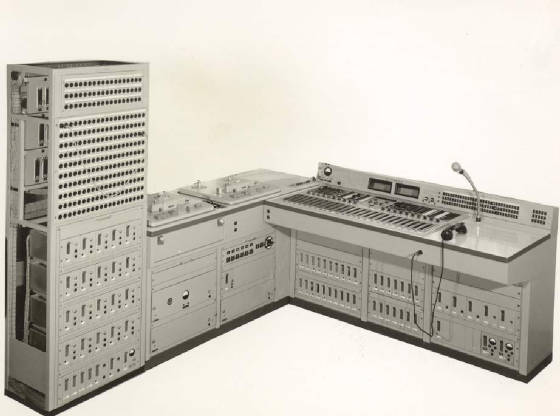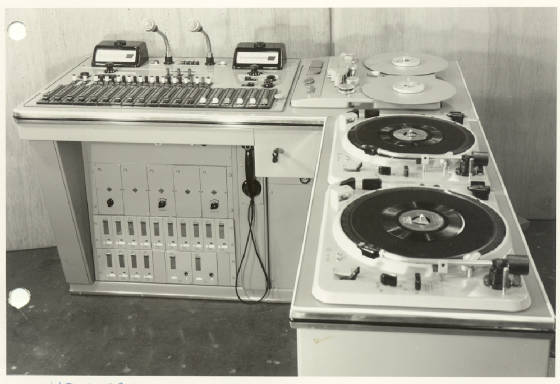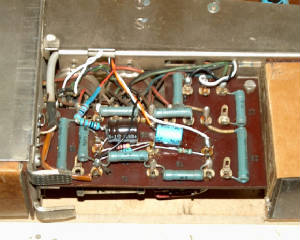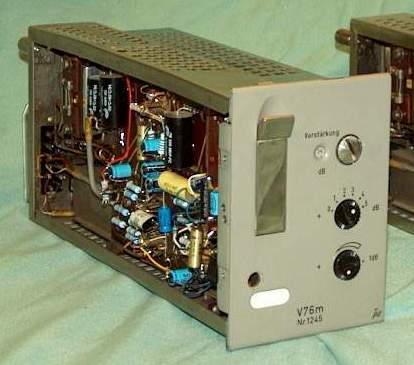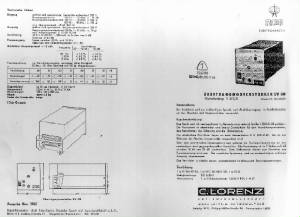The V72 and V series
The V41
In 1928, the joint venture between AEG and Siemens, simplified as Telefunken, introduced the V1 pre-amplifier that eventually became the V41 after several development stages. At its release, the V41 was a landmark of technical achievement. Driven by an EF12 tube in a steel casing, the V41 featured a frequency compensated gain control with a selector that allowed the user to switch between 20/25/30/35/40/45/50 dB. The V41 quickly became the pre-amplifier for radio stations throughout Germany and parts of Europe. After WWII, West Germany created the V41b (Telefunken/Maihak/EAB/Siemens) and continued to deploy them up to 1949.
Broadcast Development
In 1948, a Radio Conference was held in Copenhagen, Denmark for European nations to gather and determine how to parcel out the various bandwidths for radio broadcast. With the close proximity of so many sovereign states in continental Europe, the airwaves were becoming overly crowded. Germany had not been invited to this conference due to the recent ill will left over from WWII as well as the fact that it was not technically a nation at that time. The conference members did however set aside a band range for Germany. The problem was that the band range was a midrange bandwidth that was undesirable for broadcast. While the conference parceled out all of the frequencies in the medium-wave band, the Ultra Short Wave (now known as VHF) frequencies were unclaimed and unregulated. Rather than use the sub-optimal medium-wave band range assigned to them, the German radio stations decided instead to move their broadcast frequencies to the VHF range instead.
FM radio was patented in 1933 and in 1941 it was internationally recognized and authorized for use. By 1948, it was still in very limited use. The German engineers realized that FM transmissions worked much better in Ultra Short Wave frequencies than AM and that FM delivered a far superior audio quality than AM. While the rest of the world clung to AM for its long distance capabilities, Germany embraced FM out of necessity and soon became its pioneer and champion.
While FM broadcasts could achieve better sound quality it also more easily exposed flaws in the old equipment. German engineers realized that the equipment would need to be upgraded in order to provide a wider range of frequency response and a lower signal to noise ratio. Additionally, most of the pre-war broadcast equipment had been either destroyed or removed during the war to limit Germany’s communication capabilities and so many stations needed to be restocked with equipment. Both of these scenarios provided the perfect opportunity to upgrade the entire broadcast system in what is now West Germany.
Development of the V72
The North West German Radio (NWDR) working in cooperation with the Institute of Broadcast Technology (IRT) of Hamburg developed a complete new equipment standard for the German radio network. This led to the development of the historic V72 module. The V72 was developed by the NWDR under the technical supervision of Professor Nestler between 1949 and 1952 as a microphone and main studio amplifier. Nestler had previously been the head of R&D for the AEG/Telefunken Electro Acoustic Lab (ELA).
The V72 was modeled on the V41 and the circuits are almost identical with the exception of the gain control section. The V72 also utilized modern advancements like Noval glass tubes and a smaller housing, the "Danner" cassette module. The first 100 units were built at the NWDR Zentraltechnik. Serial numbers 101 to 300 were built by Maihak. These units were built with a set of EF40 tubes, the post-war glass version of the EF12. In later models, this tube was changed out for the sonically superior EF804 and EF804S.
The V72 was a self contained amplifier with a fixed gain level of 34 dB. It was originally used as a microphone amplifier used in conjunction with a Neumann W75k high pass filter and as a buffering amplifier to make up for loss of the passive fader like the Danner MR66/88 and Eckmiller W86 EQs. By 1955 it was the standard pre-amplifier in German radio stations. With the introduction of the V76, it was replaced as an input module and relegated to use as a buffering amplifier. In 1963 it was decommissioned by the IRT and replaced by the V72t transistor version.
An estimated 25000 V72 modules were built for the German Radio Network alone. The early versions were built by Maihak and Telefunken/AEG. In 1954 Siemens and TAB became sub contractors to make the historic V72. Aside from the German radio stations, the V72 was used by most of the European Recording Companies like EMI, Decca/Telefunken, etc. Siemens designed the V72s to accommodate the specific needs of these recording studios. These units featured a fixed gain of 40 dB and lower input impedance.
Telefunken used the V72s as standard preamplifiers for their broadcast division. In 1960 AEG-Telefunken was the world's largest manufacturer of broadcast systems and sold these units to radio stations in South America, Africa and the Middle East, where most of them are still in use today. In 1966 the production of the V72 stopped at Telefunken. Siemens stopped their production in 1964 but built the V72b version up until to 1966. TAB was the only company that built the V72a up into the 70s.
The Historic V72, Today
Today the V72 is still in demand, but most units are now at least 35 years old and need to be rebuilt or refurbished. The electrolytic caps of the power supply are dried out and need to be replaced. The silk-wire of the unit falls apart to the touch and in most cases this winds up shorting out the input and output transformers. The units also suffered when given phantom power. If a standard on/off phantom power supply was used, it would send an arc of electricity up to 2000V across the input transformer that would slowly burn the transformer’s insulation, thus destroying it. Most historic V72 units purchased second hand need to be completely refurbished (new caps, wiring, transformers and tubes) in order to operate at their designed specification.
The V72 Family
Technically speaking, there is a family of V72 type amplifiers that were built around the V72 circuit: the V71, V76, V77 and V78. The close relatives to the V72 are those units that matched the technical data of this little giant, but used a different circuit like the V72a, V72b, V72s, V74a, V70, and V77b.
The V71 was only made by Malotki and was a half size Danner module (without power supply) that incorporated the V72 circuit. The gain could be set with a resistor from 19 to 43 dB and needed an external N52 power supply.
The V72a was the TAB follow up of the V72. The circuit is quite different, incorporating an EF95 and E180F pentodes, and directly related to the V74a. The sound of this mic pre was different but was a better following/buffering amp than the V72 because it could take the higher output level of the V76 without distorting. Some people call it the poor man's V72 because it is easier to find than the V72. Both versions, V72/74, have problems mostly with the input transformer; as they are usually either blown or missing one leg.
The V72b was the Siemens follow up of the V72; a symmetric/balanced mic pre incorporating the E283CC and the E88CC. It was completely different in design to the V72 but sonically on the same level, with better S/N ratio and inter-modulation distortion. It is a good mic-preamp but a much better mastering amp, directly related to the V70 and V77b. Like the V72a the V72b could also easily take the high output level of the V76 with way more head room.
The V76 designed and made by TAB was two V72 modules cascaded in series with additional control features. The unit was capable of achieving 76 dB of gain and driving a signal farther with little to no loss. More importantly, the unit came with a switchable input pad. This allowed the user to change the gain in 6 dB steps across 12 positions- much more control than the V72. Additionally, the V76 typically came with either an 80 Hz or 120 Hz shelf EQ (a V76s version had no shelf EQ and a full frequency repsonse from 20 Hz to 20KHz) allowing the user to get rid of rumble from the mic stand when recording voice. Although the high end frequencies sound muffled when compared to a V72, many engineers preferred the unit due to the controls, increased gain and huge bass sound that it delivers.
The V77 was a Siemens made supercharged V72 with a maximum gain of 80 dB. It produced sound like a V72 but with the gain of the V76. With an external switch (W77) the gain could be adjusted from 0 to 80 dB. Tube set-up, choke and output transformer are all identical to the V72. The input transformer is wound the same way but with a 1 to 40 ratio, because in order to get the required S/N ratio the V77 needed a different power transformer with two separate filament windings.
The V77b is a V72b that has the V77 conversion mentioned above done to it. It is considered by many to be the greatest mastering tube amp of all time.
The V78 was a general purpose or talkback version for the German radio station with an adjustable gain up to 70 dB. Sound and S/N ratio is quite different, even with the circuit and transformers being the same. The difference is because the input and output transformers are hooked up in a different way so that the unit loses its sound character. The V78 is quite easily changed back to meet the V72 specifications.
V241: The East German "V72"
East Germany built the V41b until 1958 (Funkwerk Erfurt/C. Lorenz AG/RFT) and then replaced it with their new model, the V241. This version was more like a mix between the old V41 and the western V72. The tube setup was an EF866 (made by the East German TFK) that is similar to an EF806s and an ECC85. The gain control featured the old V41-style circuit. The V241 was built by RFT, and in 1975 was replaced by their transistor version.
Also Read:

